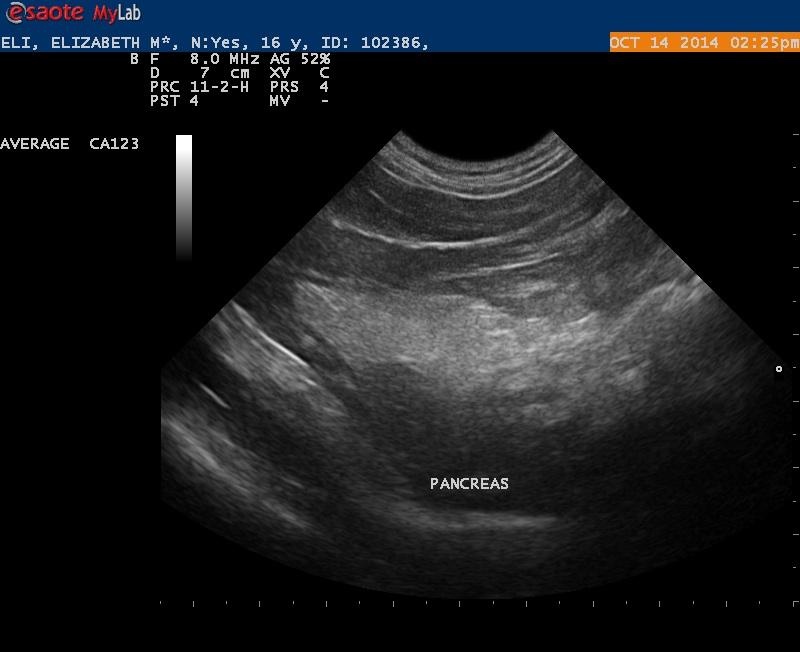Eli is a 16 year old DSH with a recent history of vomiting.
Lab results: abnormals
ALP 74 (12-59)
SPECfPL: 3.8 (3.6-5.3- cat may have pancreatitis)
UA: 3+ hematuria 4+ protein. No bacteria noted and no WBC’s. MIC is pending.
Eli is a 16 year old DSH with a recent history of vomiting.
Lab results: abnormals
ALP 74 (12-59)
SPECfPL: 3.8 (3.6-5.3- cat may have pancreatitis)
UA: 3+ hematuria 4+ protein. No bacteria noted and no WBC’s. MIC is pending.
I did an ultrasound on Eli and when evaluating the R side I saw a large hyper-echoic area that appears to be in the area of the R horn of the pancreas. I assume this is fat. I would appreciate some feedback. I have only seen a couple of pancreatitis cases and most of the ones I have seen are hypo-ehoic except for the surrounding fat. I am enclosing 2 still of the right side and one still of what I presume to be L horn of the pancreas- which I think was OK. Any feedback on this large hyper-echoic region would be appreciated.



Comments
Hello Randy sorry for the
Hello Randy sorry for the delay our alert emails were down so I just saw this but our policy is to respond wihtin 24 hours.
Best to assess panc lesions on video but the key to identifying the pancreas is following the curvilinear contour of the panc duct (large yellow arrow in your image attached) and pancreatic capsule (blue arrows in my image) Any fuzzy ill-defined changes (small yellow arrows) are what you want to look for and assess if the patient is demonstrating pain there. You can also fna the hypoechoic areas of you are good with a needle.
Attached is a normal dog pancreas (blue arros on the capsule and p-duct dual echogenic line in the middle) and compare with the adjusted one of your images with the yellow arrows.
Just search pancreatitis in the basic search (http://sonopath.com/members/case-studies/search) and you will see ad nauseum the patterns of fuzzy (inflammation) and bumpy irregular capsules associated with active and ex omnibus panc lesions
Hello Randy sorry for the
Hello Randy sorry for the delay our alert emails were down so I just saw this but our policy is to respond wihtin 24 hours.
Best to assess panc lesions on video but the key to identifying the pancreas is following the curvilinear contour of the panc duct (large yellow arrow in your image attached) and pancreatic capsule (blue arrows in my image) Any fuzzy ill-defined changes (small yellow arrows) are what you want to look for and assess if the patient is demonstrating pain there. You can also fna the hypoechoic areas of you are good with a needle.
Attached is a normal dog pancreas (blue arros on the capsule and p-duct dual echogenic line in the middle) and compare with the adjusted one of your images with the yellow arrows.
Just search pancreatitis in the basic search (http://sonopath.com/members/case-studies/search) and you will see ad nauseum the patterns of fuzzy (inflammation) and bumpy irregular capsules associated with active and ex omnibus panc lesions
Thanks EL
Eli has pain in
Thanks EL
Eli has pain in that region and I clearly see the hypo-echoic regions now.
I will get a FNA of that area if the owner is willing. I am currently treating for pancreatitis.
Thanks EL
Eli has pain in
Thanks EL
Eli has pain in that region and I clearly see the hypo-echoic regions now.
I will get a FNA of that area if the owner is willing. I am currently treating for pancreatitis.
With the normal fPL, you also
With the normal fPL, you also need to consider IBD/emerging lymphoma – did the intestines appear thickened on the US? What did the kidneys look like as hematuria may be of renal orgin and causing some pain if there is a renolith, neoplasia, or pyelectasia.
With the normal fPL, you also
With the normal fPL, you also need to consider IBD/emerging lymphoma – did the intestines appear thickened on the US? What did the kidneys look like as hematuria may be of renal orgin and causing some pain if there is a renolith, neoplasia, or pyelectasia.
The SPECfPL was in the grey
The SPECfPL was in the grey zone. I suspect there is chronicity here. Eli is coming back in tomorrow and I will look at the bladder again. The kidneys looked normal to me. I will also re-evaluate the bowel tomorrow. Thanks for the feedback riobetti.
The SPECfPL was in the grey
The SPECfPL was in the grey zone. I suspect there is chronicity here. Eli is coming back in tomorrow and I will look at the bladder again. The kidneys looked normal to me. I will also re-evaluate the bowel tomorrow. Thanks for the feedback riobetti.